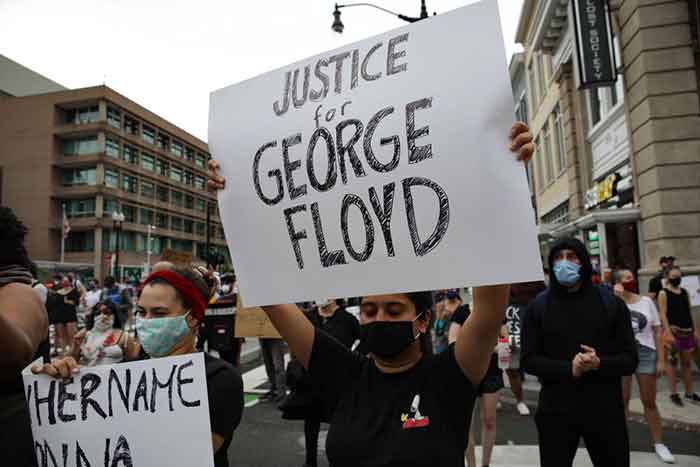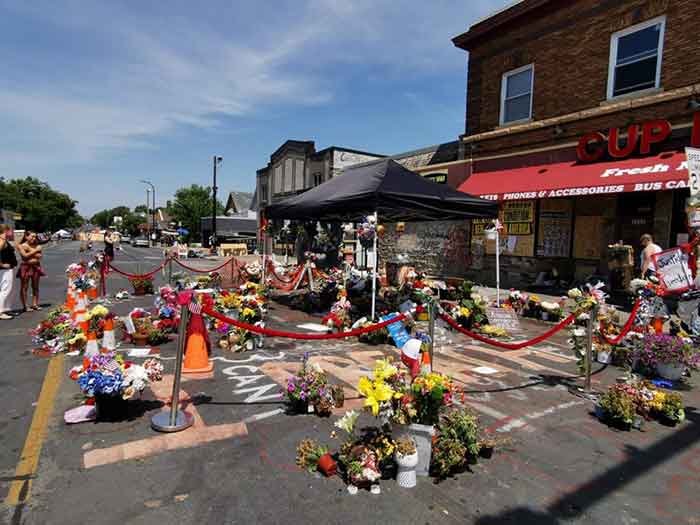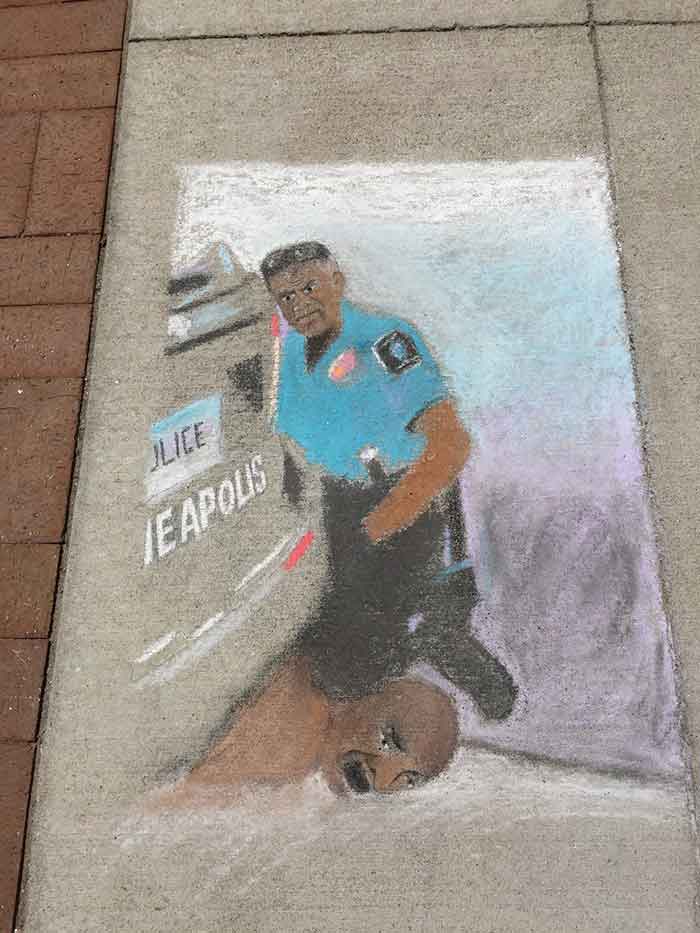
Innocent brothers and sisters it’s time to wake up, wake up, wake up
Brothers and sisters it’s time to say something, do something, make ’em
Mmm I wonder, how many Blacks lives, how many Black lives
How many heartbeats turned into flatlines
– “How Many” by Miguel
Just when the news about the way African-Americans were being disproportionately affected by the coronavirus could get no worse, just when you thought that the United States was consumed with battling the virus, came sickening, familiar news, one after another, of a kind that had not hit public notice for a while now.
First, we heard of the senseless shooting of Ahmaud Arbery, a black man out for a run in Georgia. Then came the incident where a white woman in Central Park, New York, called the police on a black man who had asked her to leash her dog. Most recently, we had to bear witness to the horrific murder of George Floyd when a police officer pinned his neck down with his knee.
All three incidents involved the common figure of the black person perceived as a threat.
The scenarios above are familiar ones too – white folk suspicious of black folk in their vicinity and either taking action themselves (Arbery) or immediately calling the police for intervention (Cooper); a law-enforcement officer using excessive force to restrain and punish a black man suspected of some wrongdoing (Floyd).
The second scenario is commonly labeled as “police brutality.” It describes situations in which police officers, often white, bring to bear excessive force on black suspects. This could be in the form of either employing a physical restraining force as with George Floyd in Minneapolis most recently and with Eric Garner in New York in 2014, or shooting at them if sensing even the slightest threat, as in the cases of Michael Brown in Ferguson in 2014 – and hundreds of others over the years!
The August 2014 Michael Brown incident, close on the heels of the July 2014 killing of Eric Garner, set off massive protests in Ferguson (Missouri), which later spread throughout the United States. The state of Missouri had to employ heavily militarized additional forces, to bring the violence under control.
Though a lot of soul-searching and analysis resulted from the manifestation of public anger in Ferguson, from trying to understand the socio-economic divides to thinking of the issues with police biases and training, that did not do much to put the brakes in racist police behavior throughout the US, even in the same year.
In November 2014, police in Cleveland Ohio, shot and killed 12-year-old Tamir Rice, who was playing in a public park. He was reported by someone in a call to the police as carrying a weapon, “probably fake.” Indeed, it turned out that Rice had a toy gun in his hands. Rice was, however, shot within seconds of the police arriving on the scene.
The list of unarmed black victims of police violence for 2014, just as an example, as maintained by the website Mapping Police Violence is depressingly long, as it is for years before or after. That not much has changed in the years following Ferguson is evident as also detailed in this recent piece from The Guardian titled, ‘Police violence in America: six years after Ferguson, George Floyd’s killing shows little has changed’.
As former President Obama, quoted in the article, put it recently, “We have to remember that for millions of Americans…being treated differently on account of race is tragically, painfully, maddeningly ‘normal’ – whether it’s while dealing with the healthcare system, or interacting with the criminal justice system, or jogging down the street, or just watching birds in the park.” Obama should know – Ferguson erupted during his presidency.
Earlier, in 2013, Trayvon Martin, a 17-year-old African-American boy was shot by a local security officer on suspicion of being an interloper in the neighborhood he was in. When the security officer was later acquitted by the courts, the Black Lives Matters movement was conceived of as a platform to rally around. The movement gained strength following the 2014 incidents of police killings.
Protests by the African-American community over police action, such as in Ferguson or in Minneapolis currently, have a long history in the US. These have included the Watts rebellion in Los Angeles in 1965, the Newark riots of 1967 and the protests following Rodney King’s murder in Los Angeles in 1992. Other more recent protests were triggered by Tim Thomas’ murder in Cincinnati Ohio in 2001, Oscar Grant’s shooting in Oakland in 2009 and the death of Freddie Gray in police custody in 2015 in Baltimore.
The much celebrated and emulated Black Panther Movement in the late 60s and early 70s also took off after constant run-ins with the local police in Oakland, California. It was the Hunter’s Point riots that followed the killing of an unarmed black man, Matthew Johnson, that saw the emergence of the Black Panthers who took it upon themselves to monitor the police while openly carrying arms themselves.
There have been constant struggles and investigations in different areas to address the issues of the socio-economic disadvantages of African-Americans, from biases in allocation of state resources for basic social goods to the mass incarceration of black people to instill fear in the community and remove its working adults to prison.
But alongside all this, the confrontation with law-enforcement has been a constant. Terms like “Driving While Black (DWB),” which point to the high incidences of black folk being pulled over while driving without adequate reason, have long been in mainstream parlance.
In many cases, a simple instance of being pulled over can turn fatal, as in the case of Sandra Bland in Texas in 2015. She protested for being stopped for what seemed like a minor infraction and the exchange with the police officer quickly escalated such that he had her arrested and sent to prison. Three days later she was found hanging in the jail.
While the black community has had a fraught and fatal relationship with the police over the years, the white community has generally trusted the police implicitly. According to a Pew Center report, “A survey conducted in mid-2017 asked Americans to rate police officers and other groups of people on a “feeling thermometer” from 0 to 100, where 0 represents the coldest, most negative rating and 100 represents the warmest and most positive. Black adults gave police officers a mean rating of 47; whites gave officers a mean rating of 72.”
Whites and blacks have very different experiences when dealing with the police. Blacks, in fact, often end up being victimized when they seek the police’s intervention. But the experience the white folks have is markedly different.
As an article explains, “Whites calling the police…do not endure long response times, treatment that negates their victimization, or the slide from victim to suspect in the eyes of the police…even when whites have involuntary contact with police, they overwhelmingly experience the police as helpful, benevolent, fair, and efficient problem solvers.”
As the article goes on to say: “This mismatch in experience equates to powerful incentives for people of one racial group to call the police on others who could be seen as breaching ‘white space.’”
Many people have tried to understand the history behind the recent cases of police targeting of black folk. In the US South, a lot of the early policing was linked to maintaining the system of slavery, as an article explains. In the US North, even if the police started out as a municipal force, they were expected to control “a “dangerous underclass” that included African Americans, immigrants and the poor.”
According to the same piece, “controlling disorder, lack of adequate police training, lack of nonwhite officers and slave patrol origins – are among the forerunners of modern-day police brutality against African Americans.”
A discriminatory regime of laws promulgated after the conclusion of the American Civil War (1865), called the Jim Crow laws, put into practice leagalized racial segregation in the US. It was the police who were often called in to enforce the specifics of the laws, further entrenching the biases against the black population.
The police are not separate from the larger beliefs and attitudes in a society. A historical stance of African-Americans as second class citizens, as dictated by the politics of disposability, dominates the common attitudes and public policy: “It is a politics in which the unproductive (the poor, weak and racially marginalized) are considered useless and therefore expendable…in which entire populations are considered disposable, unnecessary burdens on state coffers, and consigned to fend for themselves.”
Consider the Washington DC mayor’s recent comment on how the federal government looks at the risk of reopening the economy after the Covid-19 lockdown, while considering the possible fatalities, especially among blacks: “There is this kind of a callous calculation happening that surprises me…It’s kind of like, ‘Well, this COVID is killing old people and, Oh, well. It’s killing black people, and poor people and essential workers. Oh, well.’”
To such deeper and older accounts of systematic neglect and marginalization of African-Americans, and their targeting by law enforcement, is joined the more recent story of America’s notorious “war on drugs.”
As Michelle Alexander, legal scholar and author of the book, The New Jim Crow, explained in an interview, “So, you know, after the drug war was declared…crack hit the streets and really began to ravage inner-city communities, and…a wave of punitiveness really washed over the United States…The drug war was a literal war. It has been, it continues to be, a literal war waged in poor communities of color complete with SWAT teams and military-style equipment and tactics…”
This greater police presence in black communities increased the chances of violent encounters and in many cases, resulted in black folk being swept up into the mass incarceration system, as Alexander explains above.
Other historians push the increased policing and surveillance even further back to the mid-60s into the early 70s. This was the time of the black unrest in places like Newark and Watts and the rise of the Black Panthers.
President Lyndon Johnson, who formulated a “War on Poverty” program to address the disaffection in the black community also sanctioned a “War on Crime,” as historian Elizabeth Hinton has shown. “By 1965, Johnson had formulated a new initiative, what he called a ‘War on Crime.’ He sent to Congress a sweeping new bill that would bulk up police forces with federal money and intensify patrols in urban areas…His initiatives provided money for police to arm themselves with military equipment — ‘military-grade rifles, tanks, riot gear, walkie-talkies, helicopters, and bulletproof vests.’”
What is abundantly clear is that the police have always been the frontline of an apathetic and skittish administration, which has deliberately under-invested in the upliftment of African-Americans. The police, especially the white officers, do their superior’s bidding besides imbibing all the common prejudices against the African-Americans.
Such is the threat that an oppressed, marginalized, brutalized community poses to them that their immediate reaction, despite whatever their training manual says, despite a child or an adult in front of them who is unarmed, is to pull their gun and deal with the supposed threat first.
But the story of the economic disadvantages that the African-Americans suffer from cannot be ignored. Though, as several incidents including the one with Harvard professor Henry Louis Gates have demonstrated, more well-placed blacks are not necessarily exempt from being stereotyped and viewed with suspicion, the likelihood of poorer blacks being the target of police violence is greater.
The sharp economic divides between blacks and whites are evident in most places in the US. Minneapolis, in the white-majority state of Minnesota, has parts that are poor and economically depressed. As an African-American city official from Minneapolis wrote recently, “Minneapolis hosts some of the worst disparities between black and white success in America.” Similar glaring gaps were found in the areas surrounding the town of Ferguson where protests had broken out in 2014.
While police brutality is certainly a real, existential issue for black Americans, the calamity of the coronavirus has laid bare their vulnerabilities in a stark and undeniable manner. Police brutality and the threat posed by the black body seems embedded deep in America’s history and psyche. So is the socio-economic marginalization of African-Americans.
The protests and reform movements, of course, rightfully seek changes to police operating procedures, greater conversation on issues of race and solutions like community-control over police. Many organizations seek a minimum of accountability to prosecute the guilty police officers and reopening of old cases to bring a sense of justice.
The tactics and beliefs of the Black Panther Party in struggling against the structures of racism and inequality can be instructive. While advocating for neighborhood self-defence groups to address issues of police brutality, they also campaigned for socio-economic rights, managing their own free breakfast and liberation school programs.
While the current anger and outrage is understandable and protesting the institutionalized racism that pervades the police force is the need of the hour, longer term goals of pressing for socio-economic changes cannot be left by the wayside. Otherwise, it is possible, little substantial difference will accrue to the lives of African-Americans.
—
Umang Kumar is a writer currently based in Delhi NCR.
SIGN UP FOR COUNTERCURRENTS DAILY NEWS LETTER












































